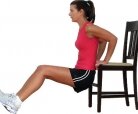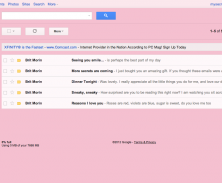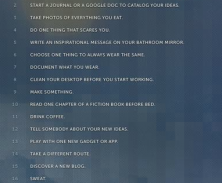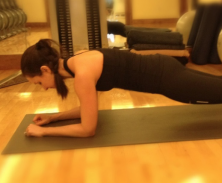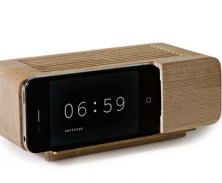Recent Stories
Filtered by: Health / Heart Rate Workouts That Make Time On The Treadmill Fly By
27,
2012
Heart Rate Workouts That Make Time On The Treadmill Fly By
Posted In: Health | Posted By: Laura
Are you looking for a new way to spice up your cardio workouts at the gym? Tired of the same old minutes spent on a treadmill, elliptical, bike, stair-stepper, etc? You’ve done the “musical chairs” on equipment to make the time pass.. a minute here, a minute there, throw in some push-ups, right? Ugh.
So, what’s the secret to an easier workout? A good playlist, of course, but even better, learning how to keep yourself so distracted by interval training and heart rate data so that you’ll hardly know the workout happened. Personally, I’ve actually become such a pro at this, that I can spend nearly TWO HOURS on a treadmill. Yes, two hours, and yes, I’m abnormal. However, there is no way I could do that without these tips I will share with you. And, music … lots of music.
First of all, you’ll want to figure out your heart rate zones. You don’t even need a heart rate monitor to do this, though if you do have access to one, definitely use it. We prefer the Polar FT7 for Men ($75), the Polar FT4F for Women, or for those that don't like watches and would rather track their heart rate from their phone, try a combination of the Garmin Heart Rate Monitor strap ($20) paired with the Wahoo Fitness Key ($76). And, for total workout tracking, download Runkeeper, which seamlessly integrates with all of these devices to display your heart rate as you workout.




Now, before you start your workout, you'll want to find your optimal heart rate zones. You can use the old-fashioned way (two fingers on the wrist or neck), or you can simply download the Instant Heart Rate app by Azumio (available in both paid and free versions for Android and ) for an easy way to take your pulse from your phone. All you have to do is press your finger to the camera lens. The camera will detect the rate of blood flow and show your pulse. (It's kind of magical.)



If you prefer to calculate your heart rate the analog way, just count your pulse for 6 seconds, then add a zero. To find your resting heart rate, try taking your pulse right after you wake up in the morning or from a nap (only when you wake up naturally, not with an alarm clock, which jumps your heart rate immediately). Most resting heart rates vary, but the “norm” is anywhere from 60-100 beats per minute. If you are an extreme athlete, it could be as low as 40 beats per minute.
Next, find your max heart rate. To do this, just subtract your age from 220. For instance, if you were 22, you would use 198 as your max. Then, subtract your resting heart rate from your max heart rate, so in our example scenario, we would use numbers like this: 198-55=143. This is your ‘total pulse range.’ (Are you writing this down?)
The last number you need to calculate is your target heart rate. You’ll only need to calculate this when you decide what type of workout intensity you want (see our sample workout below). Higher intensity workouts (70%+) are best for cardio and fitness training, while low-medium intensity workouts are better for fat burn.
Here's the key formula you need to remember:
TARGET HEART RATE = (TARGET INTENSITY % x TOTAL PULSE RANGE) + RESTING HEART RATE
Let’s put these numbers into action! Here is our favorite heart rate workout. You can try this on any type of cardio equipment, though we prefer the treadmill.
WARMUP
- Work up to a 50-60% target intensity zone, SLOWLY
This takes about a mile, or ten minutes, though take as long as you need. Depending on stress, rest, conditioning, stimulants like caffeine, nutrition, etc. Every day may be different.
SET
-1 mile @ 70% intensity
This should be aerobic and feel fairly easy but not like you want to have a conversation. If you are noticing your heart rate climbing out of that zone, SLOW down effort or intensity. Notice you can do this based on TIME or DISTANCE.
-.5 mile @ 50-60% intensity
This should feel VERY easy (since you don’t need extra recovery yet).
-.5 mile @ 80-85% intensity
This should start pushing your anaerobic zones, it’s tough but do-able and you can recover after.
-.5 mile @ 50-60% intensity
Ahhh, the recovery.
-.25 mile @ 90-95% intensity
This should be your top-end “red zone,” pushing yourself to anaerobic (out of breath) levels and absolutely needing recovery.
-.5 mile @ 50% intensity
This is your recovery, and can be used to recover before another set, or as a cool-down as you finish your workout.
This interval workout is 3.25 miles total. If you add a mile warm-up or cool-down, it could be easy to get 5 miles pretty fast. Or, you could try repeating the set a couple of times. Once you get a knack for your zones, time really does fly.
So, do your math, grab your heart rate monitor or app and before you know it, you’ll be so fit you’ll have to re-calculate your zones! How do you integrate your target heart rate zones in your workouts? Leave us a note in the comments below.
You might also like

I help people discover innovative products and ideas to live more simply, beautifully, and creatively. Read more.








